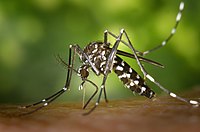
Closely Related Male-Killing and Nonmale-Killing Wolbachia Strains in the Oriental Tea Tortrix Homona magnanima
Sign Up to like & getrecommendations! Published in 2019 at "Microbial Ecology"
DOI: 10.1007/s00248-019-01469-6
Abstract: Wolbachia are inherited intracellular bacteria that cause male-specific death in some arthropods, called male-killing. To date, three Wolbachia strains have been identified in the oriental tea tortrix Homona magnanima (Tortricidae, Lepidoptera); however, none of these… read more here.
Keywords: wolbachia; wolbachia strains; male killing; host lines ... See more keywords

Transinfected Wolbachia strains induce a complex of cytoplasmic incompatibility phenotypes: Roles of CI factor genes.
Sign Up to like & getrecommendations! Published in 2023 at "Environmental microbiology reports"
DOI: 10.1111/1758-2229.13169
Abstract: Wolbachia can modulate the reproductive development of their hosts in multiple modes, and cytoplasmic incompatibility (CI) is the most well-studied phenotype. The whitefly Bemisia tabaci is highly receptive to different Wolbachia strains: wCcep strain from… read more here.
Keywords: wccep wmel; transinfected wolbachia; factor genes; wolbachia strains ... See more keywords

Wolbachia strains, and lack of genetic diversity and parthenogenesis in Brazilian populations of Tuta absoluta (Lepidoptera: Gelechiidae)
Sign Up to like & getrecommendations! Published in 2018 at "Journal of Applied Entomology"
DOI: 10.1111/jen.12531
Abstract: The pheromone‐based control of the invasive tomato pinworm Tuta absoluta (Lepidoptera: Gelechiidae) has been unsatisfactory in some cases, and parthenogenesis was reported in this species. As the parthenogenesis phenomena is a shortcoming that compromises the… read more here.
Keywords: tuta absoluta; genetic diversity; wolbachia; wolbachia strains ... See more keywords

Towards unravelling Wolbachia global exchange: a contribution from the Bicyclus and Mylothris butterflies in the Afrotropics
Sign Up to like & getrecommendations! Published in 2020 at "BMC Microbiology"
DOI: 10.1186/s12866-020-02011-2
Abstract: Background Phylogenetically closely related strains of maternally inherited endosymbiotic bacteria are often found in phylogenetically divergent, and geographically distant insect host species. The interspecies transfer of the symbiont Wolbachia has been thought to have occurred… read more here.
Keywords: towards unravelling; global exchange; unravelling wolbachia; wolbachia ... See more keywords

Developing Wolbachia-based disease interventions for an extreme environment
Sign Up to like & getrecommendations! Published in 2022 at "PLOS Pathogens"
DOI: 10.1371/journal.ppat.1011117
Abstract: Aedes aegypti mosquitoes carrying self-spreading, virus-blocking Wolbachia bacteria are being deployed to suppress dengue transmission. However, there are challenges in applying this technology in extreme environments. We introduced two Wolbachia strains into Ae. aegypti from… read more here.
Keywords: based disease; wolbachia; wolbachia strains; wolbachia based ... See more keywords

Isolation in Natural Host Cell Lines of Wolbachia Strains wPip from the Mosquito Culex pipiens and wPap from the Sand Fly Phlebotomus papatasi
Sign Up to like & getrecommendations! Published in 2021 at "Insects"
DOI: 10.3390/insects12100871
Abstract: Simple Summary Diverse strains of Wolbachia bacteria, carried by many arthropods, as well as some nematodes, interact in many different ways with their hosts. These include male killing, reproductive incompatibility, nutritional supplementation and suppression or… read more here.
Keywords: sand fly; cell lines; wolbachia strains; papatasi ... See more keywords